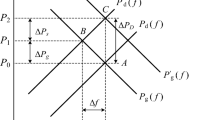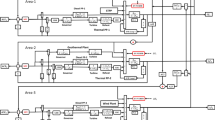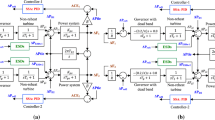Abstract
The present work has taken a challenge to design a model predictive controller (MPC) for automatic load frequency control (ALFC) of two-area, wind-integrated thermal power system equipped with battery energy storage system (BESS) and demand response (DR) for frequency regulation task. Primarily, the incremental BESS model employs a new state of charge (SOC)-based strategy to regulate the power from battery for saving battery life. Then, DR, along with the SOC-based BESS, is employed in ALFC for frequency regulation. A modified state space model of MPC incorporating all BESS variables is developed and employed in ALFC of the studied power system. The performance of the designed MPC is examined for inertia issues arising from wind in the conventional two-area power system. Furthermore, the capability of BESS for frequency regulation and effect on the life of BESS with the proposed control strategy are measured through MPC-based ALFC and results are compared with system performance when integral controller in ALFC and inertia controller from wind are present. In addition to DR and BESS in ALFC, double-fed induction generator-based proportional derivative (PD) inertia controller also contributes in the power system for frequency support from wind energy section to avoid inertia issues. So, all the controllers of the test power system such as integral controller in ALFC and PD controller in wind are tuned concurrently for smooth frequency control. However, performance of MPC is tested for smooth frequency regulation by tuning PD controller gain of wind only while keeping MPC gain parameters as available in the literature. Particle swarm optimization is used to tune the integral controller gain of ALFC for the studied power system to compare the results with MPC-based ALFC. A transfer function model of wind-integrated two-area thermal power system is taken into consideration in the present study to verify the effectiveness of the battery variable concerning MPC design for ALFC collaborating with DR for smooth frequency control and provide safe battery life. Finally, results confirm the effectiveness of the designed MPC-based ALFC, collaborating with DR- and SOC-based incremental BESS through various case studies.




















Similar content being viewed by others
Data availability
All the data used for this study are mentioned in Appendix.
References
Nguyen N et al (2021) Frequency response in the presence of renewable generation: challenges and opportunities. IEEE Open Access J Power Energy 8:543–556
Mahmoud TS, Ahmed BS, Hassan MY (2019) The role of intelligent generation control algorithms in optimizing battery energy storage systems size in microgrids: a case study from Western Australia. Energy Convers Manag 15(196):1335–1352
Tan Z, Li X, He L, Li Y, Huang J (2020) Primary frequency control with BESS considering adaptive SoC recovery. Int J Electr Power Energy Syst 1(117):105588
Li X, Huang Y, Huang J, Tan S, Wang M, Xu T, Cheng X (2014) Modelling and control strategy of battery energy storage system for primary frequency regulation. In: International conference on power system technology. IEEE, pp 543–549
Li X, Wang S (2019) Energy management and operational control methods for grid battery energy storage systems. CSEE J Power Energy Syst 7(5):1026–1040
Mercier P, Cherkaoui R, Oudalov A (2009) Optimizing a battery energy storage system for frequency control application in an isolated power system. IEEE Trans Power Syst 24(3):1469–1477
Bhuyan S, Dey SHN, Paul S (2020) Role of demand side management in automatic load frequency control. In: International conference on emerging frontiers in electrical and electronic technologies (ICEFEET). IEEE, pp 1–6
Bhuyan S, Dey SHN, Paul S, Chaine S (2021) Analysis of frequency regulation for a hydro-thermal system with ALFC-DR model. In: 2021 1st international conference on power electronics and energy (ICPEE). IEEE, pp 1–5
Bhuyan S, Halder Nee Dey S, Paul S (2022) Modified delay compensation in demand response for frequency regulation of interconnected power systems integrated with renewable energy sources. Cogent Eng 9(1):2065899
Chau TK et al (2017) Demand-side regulation provision from industrial loads integrated with solar PV panels and energy storage system for ancillary services. IEEE Trans Ind Inf 14(11):5038–5049
Shiltz DJ et al (2017) Integration of automatic generation control and demand response via a dynamic regulation market mechanism. IEEE Trans Control Syst Technol 27(2):631–646
Zhang S, Mishra Y, Shahidehpour M (2016) Fuzzy-logic based Load Frequency Controller for wind farms augmented with energy storage systems. IEEE Trans Power Syst 31:1595–1603
Han Y, Young P, Jain A, Zimmerle D (2015) Robust control for micro-grid frequency deviation reduction with attached storage system. IEEE Trans Smart Grid 6:557–565
Bevrani H, Feizi M, Ataee S (2016) Robust frequency control in an islanded microgrid: H ∞ and μ-synthesis approaches. IEEE Trans Smart Grid 7:706–717
Pan I, Das S (2016) Fractional order fuzzy control of hybrid power system with renewable generation using chaotic PSO. ISA Trans 62:19–29
Mi Y, Li D, Wang C, Loh P (2016) The sliding mode load frequency control for hybrid power system based on disturbance observer. Int J Electr Power Energy Syst 74:446–452
Wang L (2009) Model predictive control system design and implementation using MATLAB®. Springer, Berlin
Mohamed TH et al (2012) Model predictive based load frequency control design concerning wind turbines. Int J Electr Power Energy Syst 43(1):859–867
Ersdal AM, Imsland L, Uhlen K (2015) Model predictive load-frequency control. IEEE Trans Power Syst 31(1):777–785
Zheng Y et al (2017) A distributed model predictive control-based load frequency control scheme for multi-area interconnected power system using discrete-time Laguerre functions. ISA Trans 68:127–140
Khan M, Sun H (2021) Complete provision of MPC-Based LFC by electric vehicles with inertial and droop support from DFIG-Based wind farm. IEEE Trans Power Deliv 37(2):716–726
Kayalvizhi S, Vinod Kumar DM (2017) Load frequency control of an isolated micro grid using fuzzy adaptive model predictive control. IEEE Access 5:16241–16251
Dashtdar M et al (2022) Frequency control of the islanded microgrid based on optimised model predictive control by PSO. IET Renew Power Gen 16(10):2088–2100
Chen Z, Liu Z, Wang L (2022) A modified model predictive control method for frequency regulation of micro grids under status feedback attacks and time-delay attacks. Int J Electr Power Energy Syst 137:107713
Cao Y et al (2020) Multiscale model predictive control of battery systems for frequency regulation markets using physics-based models. J Process Control 90:46–55
Oshnoei A, Kheradmandi M, Muyeen SM (2020) Robust control scheme for distributed battery energy storage systems in load frequency control. IEEE Trans Power Syst 35(6):4781–4791
Khokhar B, Singh Parmar KP (2022) A novel adaptive intelligent MPC scheme for frequency stabilization of a microgrid considering SOC control of EVs. Appl Energy 309:118423
Aditya SK, Das D (2001) Battery energy storage for load frequency control of an interconnected power system. Electr Power Syst Res 58(3):179–185
Guzman ENS, Cañizares CA, Bhattacharya K, Sohm D (2020) Frequency regulation model of bulk power systems with energy storage. ArXiv e-prints
Al-Hinai A, Alyammahi H, Alhelou HH (2021) coordinated intelligent frequency control incorporating battery energy storage system, minimum variable contribution of demand response, and variable load damping coefficient in isolated power systems. Energy Rep 1(7):8030–8041
Hosseini SA, Toulabi M, Ashouri-Zadeh A, Ranjbar AM (2022) Battery energy storage systems and demand response applied to power system frequency control. Int J Electr Power Energy Syst 1(136):107680
Qays MO, Buswig Y, Hossain ML, Abu-Siada A (2020) Recent progress and future trends on state of charge estimation methods to improve battery-storage efficiency: a review. CSEE J Power Energy Syst 8:105
Chaine S, Tripathy M, Satpathy S (2015) NSGA-II based optimal control scheme of wind thermal power system for improvement of frequency regulation characteristics. Ain Shams Eng J 6(3):851–863
Chaine S, Tripathy M (2019) Performance of CSA optimized controllers of DFIGs and AGC to improve frequency regulation of a wind integrated hydrothermal power system. Alex Eng J 58(2):579–590
Stroe D, Yongcun F, Wen C, Chen Z, Fernandez C, Wang S, Chunmei Y (2021) Battery system modeling. Elsevier Science, Netherlands
Mercier P, Cherkaoui R, Oudalov A (2009) Optimizing a battery energy storage system for frequency control application in an isolated power system. IEEE Trans Power System 24:1469–1477
Knap V, Sinha R, Swierczynski M, Stroe DI, Chaudhary S (2014) Grid inertial response with Lithium-ion battery energy storage systems. In: 2014 IEEE 23rd international symposium on industrial electronics (ISIE), Istanbul, pp 1817–1822
Schwenzer M et al (2021) Review on model predictive control: An engineering perspective. Int J Adv Manuf Technol 117:1327–1349
Poli R, Kennedy J, Blackwell T (2007) Particle swarm optimization: an overview. Swarm Intell 1:33–57
Charles K, Urasaki N, Senjyu T, Elsayed Lotfy M, Liu L (2018) Robust load frequency control schemes in power system using optimized PID and model predictive controllers. Energies 11(11):3070
Funding
We have not received any funding support from any organization.
Author information
Authors and Affiliations
Contributions
The corresponding author SB developed the theory and performed the computations by taking idea from Dr. SHnD and Dr. SP. She wrote the manuscript with support from Dr. SHnD and Dr. SP. All authors discussed the results and contributed to the final manuscript.
Corresponding author
Ethics declarations
Competing interests
The paper titled “A robust MPC design concerning on battery variables for frequency regulation and saving battery life collaborating with demand response for a multi-source integrated power system” declares on behalf of all the authors that work done for the above topic is real and there is no conflict with other research available in the literature.
Ethical approval
This declaration is “not applicable”.
Additional information
Publisher's Note
Springer Nature remains neutral with regard to jurisdictional claims in published maps and institutional affiliations.
Appendix A
Appendix A
BESS parameters | ||
|---|---|---|
\(Battery \, voltages = 1755 - 2925V \, DC\) | \(C_{bp} = 52597F\) | \(K_{BESS} = 100kv/pu.mw\) |
\(R_{bs} = 0.013\Omega\) | \(X_{CO} = 0.0274\Omega\) | \(\alpha^{ \circ } = 15^{ \circ }\) |
\(R_{bt} = 0.0167\Omega\) | \(I_{BESS}^{0} = {0}{\text{.02213}}\) p.u | \(\begin{gathered} Base \, voltage = 10KV, \hfill \\ \, Base \, current = 200KA \hfill \\ \end{gathered}\) |
\(R_{b} = 0.001\Omega\) | \(R_{bp} = 10k\Omega\) | \(C = 40MWh\) |
\(C_{b} = 1F\) | \(T_{BESS} = 0.026\sec\) | \(SOC_{ref} = 0.5\) |
Power system parameters \((Base \, power \, = 2000MW)\) | |||||||||||
|---|---|---|---|---|---|---|---|---|---|---|---|
Area no | KP (Hz/pu.MW) | K r | Tr (sec) | Tp (sec.) | f (Hz) | Tg(sec) | Tt (sec) | R (Hz/pu.MW) | H | D (pu.MW/Hz) | B (pu.MW/Hz) |
1 | 120 | 0.5 | 10 | 20 | 60 | 0.08 | 0.3 | 3 | 4.7104 | 8.33 × 10–3 | 0.3417 |
2 | 120 | 0.5 | 10 | 20 | 60 | 0.08 | 0.3 | 3 | 4.7104 | 8.33 × 10–3 | 0.3417 |
MPC Parameters:prediction horizon = 10,control horizon = 2,weights on manipulated variables = 0.8,weights on manipulated variable rates = 0.10, weight on output signals = 0.10
PSO Parameter:number of particles = 20,maximum inertia weight = 0.9,minimum inertia weight = 0.4,acceleration factor (c1& c2 are): c1 = 2; c2 = 2,maximum number of steps = 20,dimension of the problem = 3
Rights and permissions
Springer Nature or its licensor (e.g. a society or other partner) holds exclusive rights to this article under a publishing agreement with the author(s) or other rightsholder(s); author self-archiving of the accepted manuscript version of this article is solely governed by the terms of such publishing agreement and applicable law.
About this article
Cite this article
Bhuyan, S., Halder nee Dey, S. & Paul, S. A robust MPC design concerning on battery variables for frequency regulation and saving battery life collaborating with demand response for a multi-source integrated power system. Electr Eng 105, 4037–4059 (2023). https://doi.org/10.1007/s00202-023-01924-1
Received:
Accepted:
Published:
Issue Date:
DOI: https://doi.org/10.1007/s00202-023-01924-1




